Forest Research: Open Access
Open Access
ISSN: 2168-9776
ISSN: 2168-9776
Research Article - (2023)Volume 12, Issue 1
The study was conducted on the effect of poultry manure and biochar of poultry manure on seedling vigour of selected trees with objective to understand the influence of nursery growing media on seedlings. Albizia gummifera, Cordia africana and Miletia ferrugenia were grown in 7 different soil mixes. Treatment 1/control (3 local topsoil+2 forest soil+1 sand); treatment 2 (3 local topsoil+2 biochar of poultry manure+1sand); treatment 3 (3 local topsoil +2 poultry manure+1 sand); treatment 4 (3 local topsoil+2 equal proportion of poultry manure and biochar of poultry manure+1 sand; treatment 5 (3 local topsoil+2 equal proportion of biochar of poultry manure and forest soil +1 sand); treatment 6 (3 local topsoil+2 equal proportion of poultry manure and forest soil+1 sand); treatment 7 (3 local topsoil 2 equal proportion of forest soil, biochar of poultry manure and poultry manure+1 sand. The experiment was laid out in randomized complete block design with three replications. Seedling height and leaf number per plant were measured four times and root collar diameter three times over study period, biomass data was taken at the end. Data were subjected to ANOVA and mean were separated using LSD at (p<0.05). Result showed that height (cm), RCD (mm), leaf number per plant and fresh biomass (g) of treatment 3, treatment 2, and treatment 4 were significantly higher than other treatments. Maximum numbers of leaves per plant recorded in treatment 3 were 36%, 33% and 14% higher than the control treatment for Albizia gummifera, Cordia africana and Milletia ferrugenia respectively. Also maximum seedling height were obtained in treatment 3 which were 26.70%, 30.70% and 30.80% higher than the control treatment for Albizia gummifera, Cordia africana and Milletia ferrugenia respectively. In terms of RCD similarly the highest value 33%, 8% and 20% thicker than the control treatment respectively in A. gummifera, C. africana and M. ferrugenia seedlings. Accordingly, for all selected species, growing media comprised in treatment 3, treatment 2 and treatment 4 respectively had the greatest effect on growth parameter of seedlings.
Growing media; Soil mix; Seedling quality; Nursery
Tree nursery is a managed site designed to produce tree seedlings grown under favorable conditions until ready for desirable size of planting. Nurseries may vary in quality and quantity of planting stocks produced; however, it’s primarily aim is to produce quantity and quality seedlings to satisfy the needs of seedling use. Reasons to raise seedlings in nursery rather than sowing directly to the field include: Majority of tree plantations need to be established using seedlings grown in nurseries; some species do not seed every year, so it needs to be raised annually in nursery; slowly growing species need to be raised in nursery since they simply swamped by weeds; plantation on poor and barren sites needs vigorous seedlings raised in nursery.
Access to quality seedlings is essential component for successfulness of tree planting programs. However, in several areas including Ethiopia, poor seed germination, weak seedling growth and poor establishment that cause low rate of plant survival are observed as a constraint. Growing media is the main factor that affects the production of seedlings in nursery and its survival after field plantation. Thus, balanced growing media is needed in order to supply functional requirements for seedlings and provide good physical, biological and chemical soil properties enhance growth of plants are required[1-3].
Biochar is a carbon rich soil additive material derived from biomass by the process of pyrolysis and used to enhance soil fertility and improve plant growth. Its effect on soil fertility depends on source of biomass used and temperature of pyrolysis. Biochar produced under low temperature (<550°C) favours more soil nutrients, higher reactivity in soil fertility and contribute better soil fertility than biochar produced under pyrolysis of higher temperature. Nutrient biochar which made of high nutrient feedstock like poultry manure and farmyard manure can contribute for soil fertility than structural biochar that made from woody biomass. Nutrient biochar has high potential to increase soil porosity and infiltration rate, and reduce bulk density, improve soil stability by releasing soil nutrients and enhance soil moisture retention. Also it increases abundance of mycorrhiza, ease increased nutrient uptake by the plant roots and improve plant growth performance [4,5].
Poultry manure which is a solid excretory product of poultry is another soil additive material. It has higher amount of Nitrogen, phosphorous and potassium content than another manure of livestock. What makes it different from other manure is that, poultry manure is not simply fecal matter; but, also consists of urine, feathers, undigested food and coop bedding material. Since it contains all essential plant nutrients that are used by plants, like nutrient biochar, poultry manure has essential benefits in improving physical, chemical and biological properties of soil and thereby enhance seedling morphological growth, improve crop productivity. However, there is lack of information on the contribution of poultry manure and its biochar as a component of nursery growing media on tree seedling growth. Accordingly, this study was conducted to evaluate different mix of poultry manure and biochar of poultry manure with other components on seedling growth of selected multipurpose tree species.
Study site description
The study was conducted at nursery station of Ethiopia Forestry Development, central Ethiopia centre (9°1′6′′ N, 38°49′7′′ E, 2365.2 m a. s. l), which located in Addis Ababa city. The climate of the site where nursery station found is sub-tropical high land climate with an average annual temperature of 12.8°C and precipitation average of 1143 mm.
Experimental design
The experiment was laid out with seven treatments in randomized complete block design with three replications each and totally twenty one treatment combinations. Polybag was prepared with diameter of 10 cm and length 15 cm. Seeds of selected tree species (Milletia ferrugenia, Cordia africana and Albizia gummifera) were tested in seed laboratory of central Ethiopia environment and forest research center. The soil media were mixed and prepared from local top soil, poultry manure, biochar prepared from poultry manure, forest soil and sand in varying proportions (Table 1).
| Treatment | Treatment composition (all with 3:2:1 ratios) |
|---|---|
| T1/Control) | 3 Local topsoil+2 forest soil+1 sand |
| T2 | 3 Local topsoil+2 biochar of poultry manure+1 sand |
| T3 | 3 Local topsoil+2 poultry manure+1 sand |
| T4 | 3 Local topsoil+2 equal proportion of poultry manure and biochar of poultry manure+1 sand |
| T5 | 3 Local topsoil+2 equal proportion of biochar of poultry manure and forest soil+1 sand |
| T6 | 3 Local topsoil+2 equal proportion of poultry manure and forest soil+1 sand |
| T7 | 3 Local topsoil+2 equal proportion of forest soil, biochar of poultry manure and poultry manure+1 sand |
Note: T represents Treatment
Table 1: Soil composition of different treatments.
Growth media preparation and soil sample analysis
Local topsoil was collected from the top 20 cm of soil at the nursery corners of the research center. Forest soil was collected from Suba natural forest and poultry manure from Yaya Gulale district of central Ethiopia. Local topsoil, forest soil and sand were first air dried and sieved to remove roots, litter and stones. Similarly, poultry manure was separated from silage of crop and macroscopic/un-decomposed feather. The biochar was prepared from collected poultry manure without separating from crop silage, macroscopic/un-decomposed feather by using traditional (mound kiln) method.
For local topsoil and poultry manure one kilogram of each sample were taken separately for laboratory test. The fresh sample of poultry manure was taken to the laboratory immediately after collected from the poultry farm station to reduce high volatility of nitrogen from fresh manu. For both samples their physicochemical properties (PH, total nitrogen, available phosphorous, available potassium organic carbon and soil texture) were analyzed at Horticoop Ethiopia soil and water analysis laboratory. Soil parameters were analyzed following standard procedures and soil texture was determined by Bouyoucos hydrometer method; soil PH meter in ES ISO 10390: 2014 (1:2:5). Total nitrogen by kjeldahl method, available phosphorous by using olsen method; exchangeable potassium by ammonium acetate method and organic carbon content analyzed by Walkely and black method [6-10].
Seed sowing and management for seedling
For all treatments, mixing of substrates (farm soil, poultry manure, biochar of poultry manure, forest soil and sand) were done according to the ratios and predetermined composite. For all selected species four seeds per pot were directly sown to the pot filled with the prepared growing media. Then prepared seeds were sown based on the speed of their growth, Cordia africana and Milletia ferrugenia seeds were sown on May 05/2019 and Albizia gummifera was seeded earlier on April 15/2019 because it has slow growth than the other two species. Polybag pots were watered and mulched just after sown to create a warm condition for seed. Watering keeps on once a day until the beginning of the rainy season, but after the rainy season started, frequency of watering became decreased based on the availability of the rain. After germination seedling with vigour growth continued growing and the other was removed from the pot. As indicated in Table 2 the number of treatments for each species were seven and each treatment were replicated three times. For each individual species there were 12 pots per replication totaling 36 pots per treatment and per species.
| Data collection date (the same for all species) | ||||
| Parameter | 1st | 2nd | 3rd | 4th |
| Height (cm) | Jul 05/2019 | Aug 05/2019 | Sept 05/2019 | Oct 05/2019 |
| Leaf number | Jul 05/2019 | Aug 05/2019 | Sept 05/2019 | Oct 05/2019 |
| RCD (mm) | Aug 05/2019 | Sept 05/2019 | Oct 05/2019 | |
Note: RCD: Root Collar Diameter; Jul: July; Aug: August; Sept: September; Oct: October
Table 2: Record keeping of the activities.
Data collection method
Morphological growths of seedlings were monitored and recorded continuously until it reaches desirable size for field plantation. The morphological characteristics measured were number of leaves, stem height (cm) and root collar diameter (mm). Those parameters such as: Above ground and below ground biomass were collected at the end of the experiment. The sample of three seedlings from each replication and total of nine seedlings from each treatment were randomly selected. Belowground biomass was washed out carefully from the soil. Fresh weights of above ground and below ground biomass were weighed separately, and then the dried weight was determined after the samples had been dried in an oven at 700°C until constant weight was obtained. The data on morphological features of the seedlings were used to calculate seedling quality parameters such as root to shoot ratio which calculated from the proportion of root dry weight to the shoot dry weight and Relative Growth Rate of Height (RGRH) is calculated as (H)=(H2-H1)/(t2-t1), where H1, H2 refer to the plant height (cm) at the time t1 and t2.
Data analysis
The effect of different growing media on seedlings vigour growth of tested species were statistically compared with LSD method for ANOVA at p=0.05 levels in SPSS 20 version and Excel software.
Analytical result of poultry manure and local soil before the experiment
Pre-test results of poultry manure and local soil prior to experiment were presented in Table 3. The result indicated that poultry manure was classified as sandy clay loam and neutral pH with high sand particles. Also the results showed that it has higher available phosphorus, available potassium, organic carbon and total nitrogen contents; and lower amount of C:N ratio.
| Parameter | Code | Poultry manure | Local Soil | ||
|---|---|---|---|---|---|
| ppm | Percentage | ppm | Percentage | ||
| Available phosphorous | P | 3075.26 | 0.307526 | 16.02 | 0.0016 |
| Available potassium | K | 17084.8 | 1.70848 | 603.8 | 0.06038 |
| Organic carbon | OC | 328800 | 32.88 | 28500 | 2.85 |
| Total nitrogen | N | 35300 | 3.53 | 1700 | 0.17 |
| Carbon nitrogen ratio | C:N | 9.31 | 9.31 | 16.76 | 16.76 |
| Acidity | pH-H2O | 7.28 | 7.2 | ||
| Soil texture | |||||
| Sand (%) | 60 | 24 | |||
| Clay (%) | 28 | 54 | |||
| Silt (%) | 12 | 22 | |||
| Textural class | Sandy clay loam | Clay | |||
Table 3: Analytical result of sample poultry manure and local soil before the experiment.
The highest content of sand particles in poultry manure and minimum C:N ratio might be due to the sand used for bedding material during poultry farm practice. This result agrees with the results reported by due to their studies on different manure.
Local soil has clay texture and neutral. The manure has lower available phosphorus, potassium, organic carbon and total nitrogen contents; and lower amount of C:N ratio.
Effects of growing media on number leaves per seedling
As the result shows seedlings of Albizia gummifera (Table 4) raised with T3, T2 and T4 were significantly (P<0.05) produced maximum number of leaves per plant than those raised in other treatments. Number of Albizia gummifera leaves per plant produce in each T3, T2 and T4 were 36% higher than that of T1/control treatment, T5, T6 and T7. However, for this species the seedlings grown in T5, T6 and T7 has no significance difference from the control treatment. Similarly for Cordia africana and Milletia ferrugenia species, seedlings raised in T2, T3 and T4 produce more number of leaves per plant than in the control treatment. Even though seedlings of these species produce more number of leave per plant than in control treatment, they have no significant difference from seedlings of the same species grown in treatment T5, T6 and T7. Maximum number of leaves per plant of Cordia africana seedlings in T3, T2 and T4 each was 33% higher than those in the control treatment; whereas in Milletia ferrugenia seedlings, within all treatments the number of leaves produced per plant was 14% higher than that produced in the control treatment [11-18].
This result was in conformity with the earlier findings that seedlings treated with poultry manure produces higher number of leaves per plants than those other fertilizer treatment. Also the result in line with the study on Irvingia wombolu Vermoesen seedlings by Oroka and Ureigho that reported the maximum number of leaves per plants in seedling grown with poultry manure. Similarly, the effect of biochar and chicken manure on soil properties and growth plant by increasing plant height, number of leaves per plant, fresh biomass and improving soil chemical properties by Amaref, et al. and Qayyum, et al.
| Treatments | Albizia gummifera | Cordia africana | Milletia ferrugenia |
|---|---|---|---|
| T1/control | 11.00 ± 1.00 | 9.00 ± 1.96 | 7.00 ± 1.52 |
| T2 | 15.00 ± 1.05 | 12.00 ± 1.42 | 8.00 ± 0.83 |
| T3 | 15.00 ± 1.43 | 12.00 ± 1.62 | 8.00 ± 0.72 |
| T4 | 15.00 ± 1.66 | 12.00 ±1 .07 | 8.00 ± 1.00 |
| T5 | 11.00 ± 0.85 | 10.00 ± 1.54 | 8.00 ± 1.06 |
| T6 | 11.00 ± 0.92 | 10.00 ± 1.23 | 8.00 ± 10.1 |
| T7 | 11.00 ± 0.94 | 10.00 ± 0.81 | 8.00 ± 0.94 |
Note: T=Treatment; means in a column followed by the same letter do not differ significantly (P<0.05)
Table 4: Average mean number of leaves per seedling under 7 treatments.
Leave number increment over the time period
The number leave increment over the time period was different within different treatments. For Albizia gummifera seedling the increment in the number of leaves produced from the months of July to September showed more or less similar trend in all treatments. After September, the number of leave increment in T3, T2 and T4 respectively showed rapid increment than in other treatments. Likewise, in Cordia africana seedling, higher number of leaves increment was observed in T3, T2 and T4 respectively throughout the study period, while from months of August to September to some extent slow number of leave increments were observed in T1/control treatment, T6, T7 and T5 respectively. In seedling growth of Milletia ferrugenia species, the increments of leave number in all treatments follows the same trends until the month of September; but after September leave number increment in seedling raised with T3, T2 and T3 was somewhat decreased relative to the trends in the preceding time (Figures 1- 3).
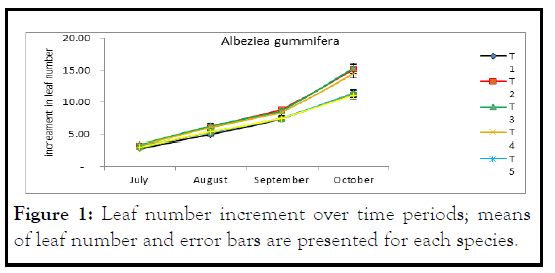
Figure 1: Leaf number increment over time periods; means of leaf number and error bars are presented for each species.
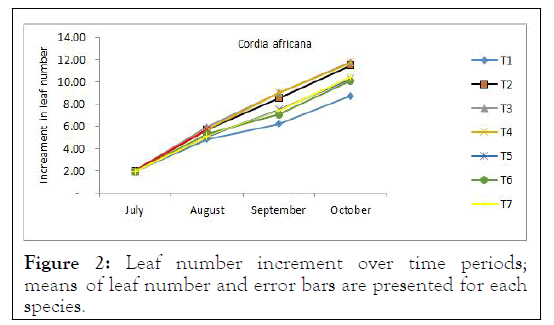
Figure 2: Leaf number increment over time periods; means of leaf number and error bars are presented for each species.
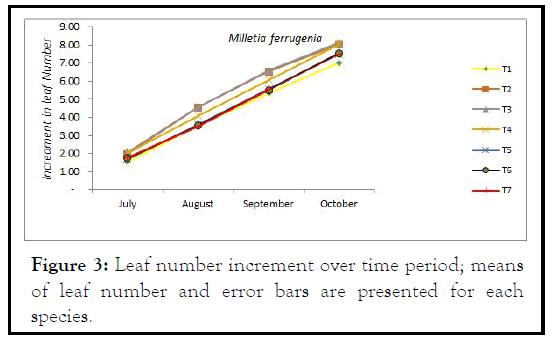
Figure 3: Leaf number increment over time period; means of leaf number and error bars are presented for each species.
Effects of growing media on height of seedlings
Seedlings of all selected species raised with growing media comprised of T3, T2 and T4 respectively showed significance difference (p<0.05) regarding to height growth (Table 5). The maximum height growth obtained in T3 was 26.70%, 30.70% and 30.80% higher than the control treatment for Albizia gummifera, Cordia africana and M. ferrugenia respectively. Comparably the effect of growing media comprised of T5, T6 and T7 on height growth of all selected species had no significant differences from the control treatment. Maximum height obtained in T3, T2 and T4 was attributed to the fact that poultry manure contains higher amount of available nitrogen, potassium, phosphorous and other nutrients, which enhance the soil nutrient status and vegetative growth; and biochar derived from poultry manure enhance soil fertility, improve soil water holding capacity and nutrient retention power.
This result in line with the result reported by who observed significant effect of poultry manure in increasing cacao seedlings height who investigated that the maximum height of Irvingia wombolu Vermoesen seedling obtained in potting media that contain mixture of poultry manure compared to other mixture of substrate. Similar results were also reported on positive effect of biochar substrate derived from manure performs maximum seedling height, also results of the study by on the effect of biochar substrate on Tectonia grandis seedlings grown in nursery indicated maximum growth performance in seedling height [19,20].
| Treatments | Albizia gummifera | Cordia africana | Milletia ferrugenia |
|---|---|---|---|
| Treatment 1 (control) | 25.31 ± 1.81 | 29.06 ± 4.02 | 30.18 ± 4.35 |
| Treatment 2 | 31.41 ± 1.76 | 36.24 ± 8.69 | 38.93 ± 7.70 |
| Treatment 3 | 32.07 ± 2.60 | 37.98 ± 7.55 | 39.49 ± 7.52 |
| Treatment 4 | 30.78 ± 2.81 | 36.19 ± 5.76 | 38.31 ± 7.10 |
| Treatment 5 | 25.48 ± 2.92 | 31.10 ± 5.79 | 32.68 ± 6.26 |
| Treatment 6 | 25.39 ± 2.59 | 30.75 ± 5.58 | 33.01 ± 5.60 |
| Treatment 7 | 25.42 ± 3.10 | 30.47 ± 4.24 | 32.98 ± 4.32 |
Note: Means in a column followed by the same letter do not differ significantly (P<0.05)
Table 5: Mean height (cm) of three multipurpose tree species under 7 treatments.
Relative Height Growth Rate (RHGR) of seedlings
The relative height growth rate of Albizia gummifera seedlings (Figure 4) follows the same trends in all treatments. The RHGR of the seedlings was increased from August to September; however, the increment rate was significant (p<0.05) only in seedlings raised with T3, T2 and T4. After the month of September, the rate of growth was relatively declined compared to the earlier month of the study period; but still the rate of height growth in seedling raised with T3 and T2 show significance (p<0.05) differences from those seedlings grown in control treatment.
In the month of August maximum rate of height increment was obtained in T3 and T2 each with rate of (0.34 cm month-1); in September the highest growth rate was recorded in T3 with rate of (0.44 cm month-1) and in October highest growth rate of (0.24 cm month-1) was obtained in T2.
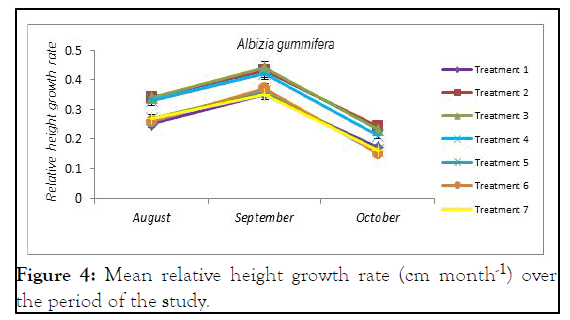
Figure 4: Mean relative height growth rate (cm month-1) over the period of the study.
In case of Cordia africana species (Figure 5) the height growth within all treatments were relatively increased through the study period; however, the rate of increment was different in all treatments over the study period. From August to September the relative height growth rate of seedlings was increased significantly (p<0.05) in all treatments, but after September the rate of height increment was significant only in T3, T2 and T4 compared to the control treatment. Over the study time, maximum rate of height increment (0.14 cm month-1) in August, (0.44 cm month-1) in September and (0.57 cm month-1) in October was observed in T3.
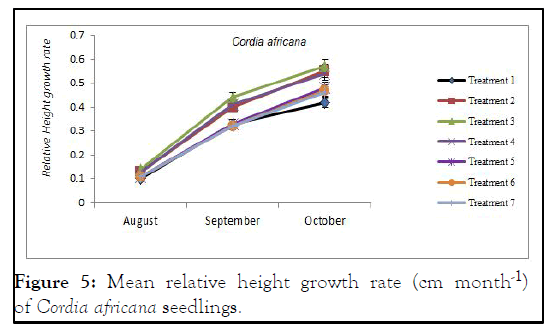
Figure 5: Mean relative height growth rate (cm month-1) of Cordia africana seedlings.
From August to October the RHGR of Milletia ferrugenia (Figure 6) decreased gradually in treatment 6, treatment 1, treatment 5 and treatment 7; and rapidly in T3, T2 and T4. Starting from September the rate of height increment rapidly increased T3, T2 and T4 respectively; and increase gradually in T6, T1, T5 and T7. From September-October, the rate of height increment was significance (p<0.05) in T3, T2 and T4 compared to control treatment. In all selected species monthly relative height growth rate during the study months showed that seedlings grown with T3, T2 and T4 respectively grew highly significantly more than the others.
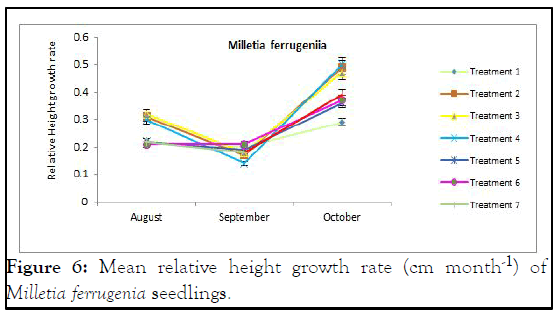
Figure 6: Mean relative height growth rate (cm month-1) of Milletia ferrugenia seedlings.
Effects of growing media on root collar diameter of seedlings
There were significant differences (P<0.05) regards to root collar diameter growth among growing media (Table 6). For seedlings of Albizia gummifera and Cordia africana species all growing media had significant effect in increasing root collar diameter compared to the control treatment, whereas in case of Milletia ferrugenia, only growing media comprised of T3, T2 and T4 had significant effect on root collar diameter growth respectively. For all selected species, maximum root collar diameter was recorded in seedling raised with T3, which are (33%), (8%) and (20%) higher than control treatment in Albizia gummifera, Cordia africana and Milletia ferrugenia respectively. As discussed above in the effects of growing media on seedling height, the significance effect of growing media on root collar diameter of seedlings might be due to the beneficial contribution of poultry manure and biochar derived from poultry manure in soil fertility improvement that enhance the increment of root collar diameter.
Similar findings were reported by who reported excellent growth of root collar diameter in seedling raised in potting media that contain mixture of poultry manure. Increasing in root collar diameter was also reported. The results are also in line with those reported by for studying the comparative effect of poultry manure and cow dung, and for studying the effect of poultry manure on of Moringa oleifera indicated that poultry manure results increased the root collar diameter of seedlings due to its high nutrient concentration and other substrates.
| Treatments | Albizia gummifera | Cordia africana | Milletia ferrugenia |
|---|---|---|---|
| Treatment 1 (control) | 3.80 ± 0.36 | 4.68 ± 0.26 | 5.95 ± 1.09 |
| Treatment 2 | 4.87 ± 0.29 | 5.01 ± 0.27 | 6.65 ± 0.90 |
| Treatment 3 | 5.06 ± 0.26 | 5.06 ± 0.20 | 7.15 ± 0.95 |
| Treatment 4 | 4.77 ± 0.46 | 4.99 ± 0.24 | 6.89 ± 0.95 |
| Treatment 5 | 4.20 ± 0.44 | 4.86 ± 0.26 | 6.37 ± 1.44 |
| Treatment 6 | 4.26 ± 0.47 | 4.85 ± 0.25 | 6.39 ± 1.14 |
| Treatment 7 | 4.23 ± 0.52 | 4.87 ± 0.23 | 6.22 ± 0.96 |
Note: Means in a column followed by the same letter do not differ significantly (P<0.05)
Table 6: Mean root collar diameter (mm) of three multipurpose tree species under 7 treatments.
Effects of growing media on biomass production
Results showed that both above ground and below ground fresh biomass of selected species were significantly (P<0.05) higher in growing media containing T3 followed by T2 and T4. In all selected species, maximum above ground fresh biomass value obtained in T3 was (20%), (22.7%) and (24.6%) higher than the control treatment for Albizia gummifera, Cordia africana and Milletia ferrugenia respectively; whereas maximum below ground fresh biomass value similarly obtained in T3 were (18%), (19.5%) and (38%) higher than the control treatment for Albizia gummifera, Cordia africana and Milletia ferrugenia respectively. Even if no significance difference was observed in above ground and below ground dry biomass similar to fresh biomass the maximum value was gained in seedling raised with T3, T2 and T4 (Tables 7-9).
| Treatments | Above ground fresh biomass | Below ground biomass | ||
|---|---|---|---|---|
| Fresh weight | Dry weight | Fresh weight | Dry weight | |
| Treatment 1 (control) | 25.23 | 16.72 | 19.57 | 14.10 |
| Treatment 2 | 30.18 | 19.11 | 23.13 | 15.47 |
| Treatment 3 | 30.36 | 19.06 | 23.14 | 15.79 |
| Treatment 4 | 29.62 | 16.92 | 23.03 | 14.77 |
| Treatment 5 | 22.94 | 15.60 | 19.81 | 13.03 |
| Treatment 6 | 24.11 | 16.00 | 19.66 | 13.16 |
| Treatment 7 | 23.61 | 15.61 | 18.81 | 12.37 |
Note: Means in a column followed by the same letter do not differ significantly (P<0.05)
Table 7: Above ground and below ground biomass weight (g) of Albizia gummifera.
| Treatments | Above ground fresh biomass | Below ground biomass | ||
|---|---|---|---|---|
| Fresh weight | Dry weight | Fresh weight | Dry weight | |
| Treatment 1 (control) | 48.36 | 26.30 | 22.52 | 13.13 |
| Treatment 2 | 59.07 | 27.27 | 26.64 | 14.69 |
| Treatment 3 | 59.33 | 30.17 | 26.92 | 15.29 |
| Treatment 4 | 57.53 | 28.17 | 26.17 | 14.57 |
| Treatment 5 | 52.56 | 26.71 | 22.88 | 13.81 |
| Treatment 6 | 45.91 | 23.11 | 22.96 | 13.78 |
| Treatment 7 | 46.62 | 23.88 | 21.54 | 12.73 |
Note: Means in a column followed by the same letter do not differ significantly (P<0.05)
Table 8: Above ground and below ground biomass weight (g) of Cordia Africana.
| Treatments | Above ground fresh biomass | Below ground biomass | ||
|---|---|---|---|---|
| Fresh weight | Dry weight | Fresh weight | Dry weight | |
| Treatment 1 (control) | 22.61 | 14.71 | 16.29 | 11.23 |
| Treatment 2 | 27.04 | 16.80 | 21.00 | 12.59 |
| Treatment 3 | 28.18 | 17.34 | 22.56 | 12.61 |
| Treatment 4 | 26.85 | 15.20 | 22.03 | 12.73 |
| Treatment 5 | 23.37 | 15.27 | 17.01 | 11.87 |
| Treatment 6 | 23.01 | 15.14 | 18.03 | 12.62 |
| Treatment 7 | 23.14 | 15.16 | 17.60 | 12.08 |
Note: Means in a column followed by the same letter do not differ significantly (P<0.05)
Table 9: Above ground and below ground biomass weight (g) of Milletia ferrugenia.
For all selected species significantly maximum fresh biomass weight obtained in seedling raised with T3, T2 and T4 might be due to superior growth attained in terms of height, root collar diameter and number of leaf produced per plants in these soil mixes that results the fresh biomass weight. The results are in line with the study conducted by on their study of the effect of biochar and increment of chicken manure highest fresh biomass of plants.
Effect of growing media on Root to Shoot Ratio (RSR)
Based on the calculated results presented in Table 10, root to shoot ratio of seedlings in selected species within all treatments were fit to the general expectations of the acceptable range (RSR<2). So, these seedlings are expected to perform properly after field plantation due to its adequate root system that will enhance the growth and performance of the plant. Similar findings were reported by and thus, adequate root systems are key to the seedlings to absorb enough amount of water and nutrients, whereas shoots provide a pathway of water, nutrients and photosynthesis between roots and leaves.
| Treatments | Albizia gummifera | Cordia africana | Milletia ferrugenia |
|---|---|---|---|
| Treatment 1 (control) | 0.86 ± 0.21 | 0.53 ± 0.13 | 0.90 ± 0.15 |
| Treatment 2 | 0.82 ± 0.14 | 0.55 ± 0.11 | 0.91 ± 0.15 |
| Treatment 3 | 0.85 ± 0.25 | 0.53 ± 0.19 | 0.66 ± 0.11 |
| Treatment 4 | 0.91 ± 0.26 | 0.57 ± 0.24 | 1.10 ± 0.18 |
| Treatment 5 | 0.87 ± 0.31 | 0.55 ± 0.17 | 0.51 ± 0.09 |
| Treatment 6 | 0.88 ± 0.37 | 0.63 ± 0.19 | 1.08 ± 0.18 |
| Treatment 7 | 0.84 ± 0.33 | 0.55 ± 0.12 | 0.73 ± 0.12 |
Note: Means in a column followed by the same letter do not differ significantly (p<0.05)
Table 10: Mean root to shoot ratio of three multipurpose tree species under 7 treatments.
Analytical results indicated that poultry manure has higher amount soil nutrient content and lower C:N ratio compared to the local soil. But this Lower C:N ratio of poultry manure might be due to the sand used for bedding material during poultry farm practice. The results of the study revealed that there were significant variations among different growth media. For all selected species, growing media comprised with the proportion of 3 local topsoil+2 poultry manure+1 sand; 3 local topsoil + 2 biochar of poultry manure+1 sand and 3 Local topsoil +2 equal proportion of poultry manure and biochar of poultry manure+1 sand respectively had the greatest effect on number of leaves produced, seedlings height growth, root collar diameter, relative height growth rate than control treatment and those other treatments in the experiment. However, root to shoot ratios in all tested species within all treatments were fit to the general expectations of the acceptable range (RSR<2). But in case of dry weight biomass no significance difference was observed among all treatments.
On the other hand, for all selected species, growing media comprised with the proportion of 3 Local topsoil+2 equal proportion of biochar of poultry manure and forest soil+1 sand; 3 Local topsoil+2 equal proportion of poultry manure and forest soil+1 sand; and 3 Local topsoil+2 equal proportion of forest soil, biochar of poultry manure and poultry manure+1 sand had no significance differences on the growth parameters of seedlings than the control treatments.
Generally, to raise quality seedlings poultry manure and/or biochar derived from poultry manure mixing with other substrate are suitable growing media for nursery operators. Based on this study it would be advisable to use poultry manure as: 3:2:1 ratio of local topsoil, poultry manure and sand respectively.
Citation: Humnessa T, Asfaw Z, Derero A (2023) Effect of Poultry Manure and its Biochar on Seedling Vigor of Selected Multipurpose Tree Species. J For Res. 12:335.
Received: 19-Sep-2022, Manuscript No. JFOR-22-19288; Editor assigned: 21-Sep-2022, Pre QC No. JFOR-22-19288 (PQ); Reviewed: 04-Oct-2022, QC No. JFOR-22-19288; Revised: 13-Feb-2023, Manuscript No. JFOR-22-19288(R); Published: 20-Feb-2023 , DOI: 10.35248/2168-9776.23.12.335
Copyright: © 2023 Humnessa T, et al. This is an open-access article distributed under the terms of the Creative Commons Attribution License, which permits unrestricted use, distribution, and reproduction in any medium, provided the original author and source are credited.